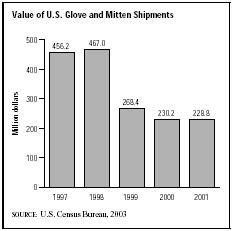SIC 2381
DRESS AND WORK GLOVES, EXCEPT KNIT AND ALL-LEATHER
This industry includes establishments primarily engaged in manufacturing dress, semidress, and work gloves and mittens from purchased woven or knit fabrics, or from these materials combined with leather or plastics. Knitting mills primarily engaged in manufacturing gloves and mittens are classified in SIC 2259: Knitting Mills, Not Elsewhere Classified; establishments primarily engaged in manufacturing leather gloves are classified in SIC 3151: Leather Gloves and Mittens; those manufacturing sporting and athletic gloves are classified in SIC 3949: Sporting and Athletic Goods, Not Elsewhere Classified; and those manufacturing safety gloves are classified in SIC 3842: Orthopedic, Prosthetic, and Surgical Appliances and Supplies.
NAICS Code(s)
315992 (Glove and Mitten Manufacturing)
Glove manufacturers produce gloves for a variety of purposes, ranging from the functional to the purely ornamental. Because of their utility in work, industry, fashion, and casual apparel, gloves have been a popular accessory for men, women, and children for centuries.
Gloves have been used since the fourteenth century B.C. Linen gloves were found in the tomb of King Tutankhamen. These accessories have served many purposes for both men and women throughout history and once were among the costliest items of clothing. In 1834 Xavier Jouvin, a French glove maker, invented a press

that could cut six gloves simultaneously, bringing down the cost and increasing their popularity and availability. About 100 years later, the Singer Co. introduced the Pique sewing machine, designed with a thin post that held the glove for sewing the fingers.
During the first half of the twentieth century, Gloversville, New York, and the surrounding Fulton County region was considered the glove capital of the world, with around 300 manufacturing companies producing 90 percent of the world's leather gloves. Shortly thereafter, the glove industry had to move production offshore to become more competitive due to rising labor costs. This move began in the 1950s and continued into the 1990s, to places like the Philippines, India, and eventually China. During 1999, glove companies began targeting niche markets, such as specialty gloves for the government, using U.S. production in Gloversville.
The two major types of gloves include work or industrial gloves and casual or dress gloves. Casual and dress gloves are different from work gloves in many ways. Unlike their more durable counterparts, they are made from finer fabrics and weaves—including linen, silk, and fine weaves of cotton and wool. Their popularity as an accessory rises and falls according to the dictates of fashion.
Since industrial gloves are designed to provide protection, they are constructed of more durable materials, such as cotton, wool, or leather. In 1999, the American National Standards Institute and the Industrial Safety Equipment Association issued a hand protection standard ANSI/ISEA 105-1999. This standard provides glove selection criteria in 12 specific categories related to testing and performance properties, including puncture resistance, abrasion, protection from heat and cold, and chemical resistance.
Some of the leading work glove manufacturers in the early 2000s were Best Glove Manufacturing, Wells Lamont, Southern Glove Manufacturing, and Magid Glove and Safety Manufacturing. These companies shipped products directly to industries and retailers throughout the year. In 2004, Wells Lamont, based in Niles, Illinois, was the largest glove manufacturer in the world. It operated as a subsidiary of The Marmon Group, based in Chicago, Illinois.
The value of total industry shipments in 2001 was estimated at $228.8 million, down from $456.2 million in 1997. Over the same time period, the value of leather and fabric combination glove shipments declined from $29.7 million to $11.6 million.
Employment by manufacturers of gloves has been on the decline since the mid-1990s. In 2000, a total of 5,068 employees worked in this industry, compared to 6,412 in 1997. About 4,148 of these employees were in production in 2000. North Carolina, Mississippi, and New York are the top producing states.
Further Reading
U.S. Census Bureau. "Statistics for Industry Groups and Industries: 2000." February 2002. Available from http://www.census.gov/prod/2002pubs/m00as-1.pdf .
——. "Value of Shipment for Product Classes: 2001 and Earlier Years." December 2002. Available from http://www.census.gov/prod/2003pubs/m01as-2.pdf .
Comment about this article, ask questions, or add new information about this topic: